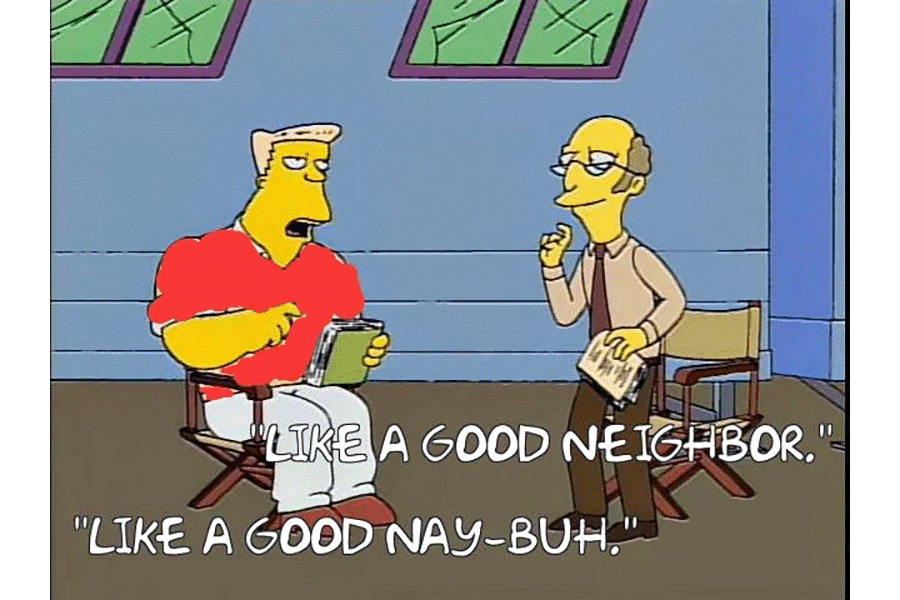Warning: This is a purely, off-the-cuff and subjective analysis. The point isn’t to prove that State Farm had the best Super Bowl ads (although USA Today’s survey DOES have them as the winner).
The point is to look at their ads using the same fundamental framework that can make YOUR ads more effective.
Because, frankly, dear reader, I don’t give a damn about State Farm — I care about you and your business.
So, first things first: if you haven’t seen the State Farm Super Bowl ad (or want to see it again), here it is.
Now, let’s talk about the Three Fundamentals that make this ad a winner
1. The Ad is Easily Understood by a Distracted Audience
Like most people, I caught the game while attending a Super Bowl watch party.
Meaning it was noisy and my attention was divided between conversations, stuffing my face with exquisitely unhealthy foods, swigging my beer, and watching the action.
So most ads that required my full and undivided attention left me scratching my head.
And to be fair, several of those ads continued to make little or no sense even after I watched them with full attention in the quiet of my office.
But the important take-aways are:
- Ads should be crafted to succeed in a world of divided and partial attention.
- Simple storylines beat convoluted plots.
- Familiar situations and rituals with the right amount of strangeness and trouble beat entirely weird and fantastical set-ups.
- And heavy use of Brand Codes is all important.
If you look at the State Farm ad, the set-up and storyline are easily grasped and achingly, even humorously, familiar.
What’s the set-up?
It’s a standard Action Flick Trope to have the hero saving the lives of innocent bystanders (or would-be victims).
And the “behind the scenes” or “making of” look at said action flick.
Anyone can get the set-up immediately.
And then when the action hero is cultural icon Arnold Freakin’ Schwarzenegger, and the humor hinges on his famous accent, everything immediately clicks.
Even better, if it doesn’t click right away cause you missed that moment while stuffing your face or talking, the “Neighbaa” joke is repeated 10+ times.
The viewer can’t help but get it, even while distracted by beer, conversation, chips, dips, wings, and possibly a full bladder.
2. The Humor Is Integrated Into and Reinforces the Brand Codes
Note well that the entire joke hinges on Arnie saying State Farm’s key slogan:
“Like a good neighbor, State Farm is there.”
The joke isn’t superfluous to the branding, it IS the branding.
Even better, we recognize that action-hero Schwarzenegger is playing the role of a State Farm agent as soon as we see him in “Jake From State Farm’s” famous red polo and khakis (while being directed by Jake From State Farm version 2.0).
The entire ad is loaded with State Farm’s Brand Codes, from the slogan to the colors and clothing, to the characters, and right to the jingle at the end.
And this makes it impossible to forget who the commercial is advertising.
This is important since 40% of remembered ads are misattributed to the wrong brands in tests of ad recall.
You don’t want people to remember your ad but forget you and your brand.
3. The Humor IS the Persuasion
The most powerful persuasion is often buried in the set-up.
It’s the pill you have to swallow if you want to understand the story, and therefore go for the humorous or emotional ride offered by the narrative.
And since our sense-making skills kick in automatically and subconsciously, we never get to question whether we want to swallow that pill or not.
For the State Farm ad, the persuasive pill is the notion that State Farm agents do heroic stuff — because they’re there when you really need them.
Such that while it may be a funny and over-the-top exaggeration to have an action-hero legend play the part of a State Farm agent, it’s not inconceivable.
It’s an exaggeration, but not a contradiction.
So when you watch this ad and laugh at Arnold’s iconic “Neighba!,” you’re subconsciously accepting the fact that State Farm agents really do help their clients through difficult situations, such as in the aftermath of a house fire.
Do Your Ads Measure Up to the State Farm Standard?
Ask yourself:
- Do your ads make heavy use of Brandable Chunks and other Brand Codes, to include jingles and earworms?
- Do your ads make use of storytelling?
-
- If so, are your storylines relatable and easily understood?
-
- Are you effectively burying your key persuasive points in the pre-suppositions and set-up to the story?
- Do your ads entertain? And is the entertainment intrinsic to the persuasion?
If your ads are falling short, why not launch a better campaign for 2024 with some expert help?
- Getting a Foot in the Door — Of Perception - November 27, 2025
- What Digital Superstars Know About Offline Advertising - November 17, 2025
- Unmistakable: A Tale of Two Boots and Branding Done Right - November 8, 2025

